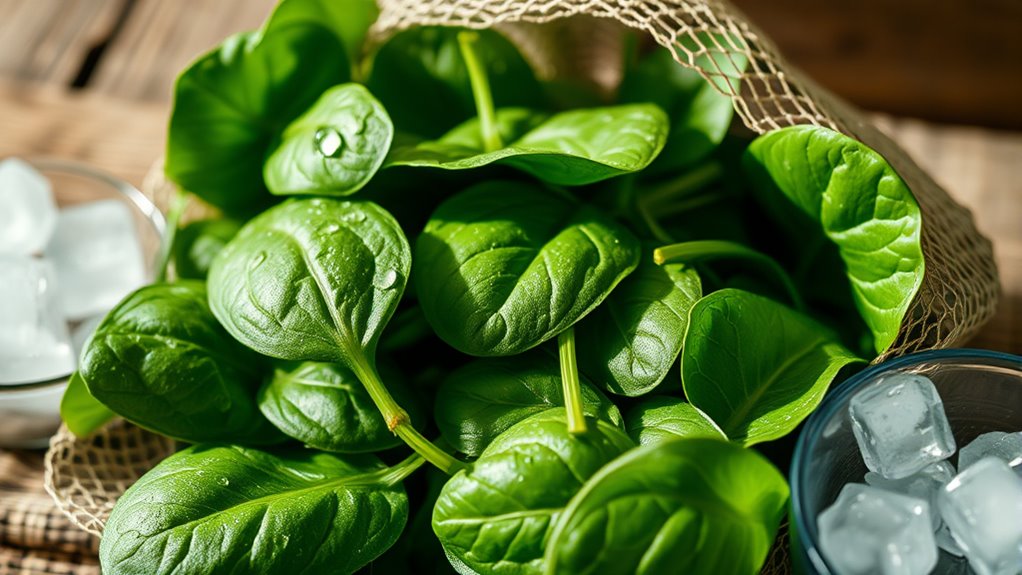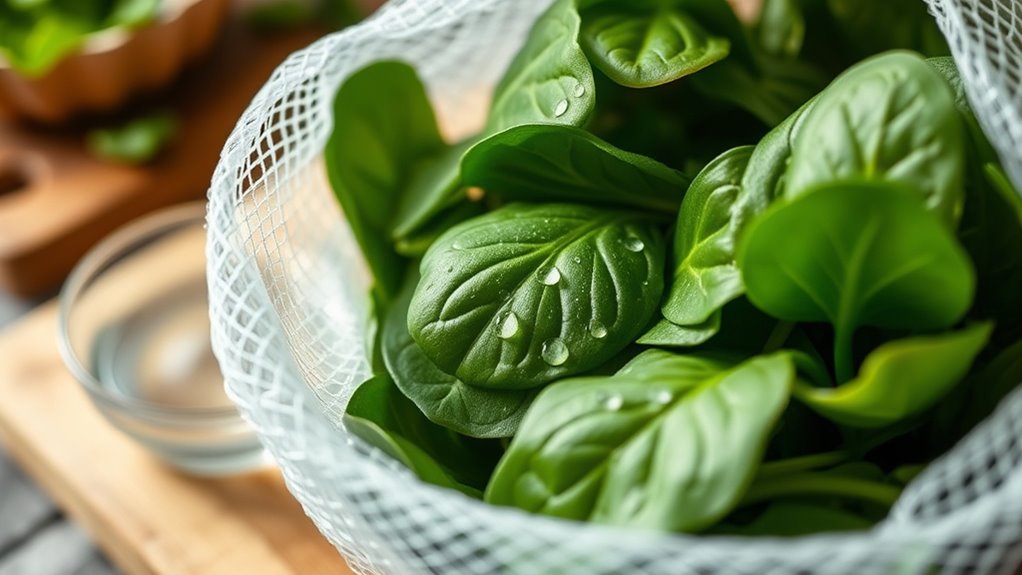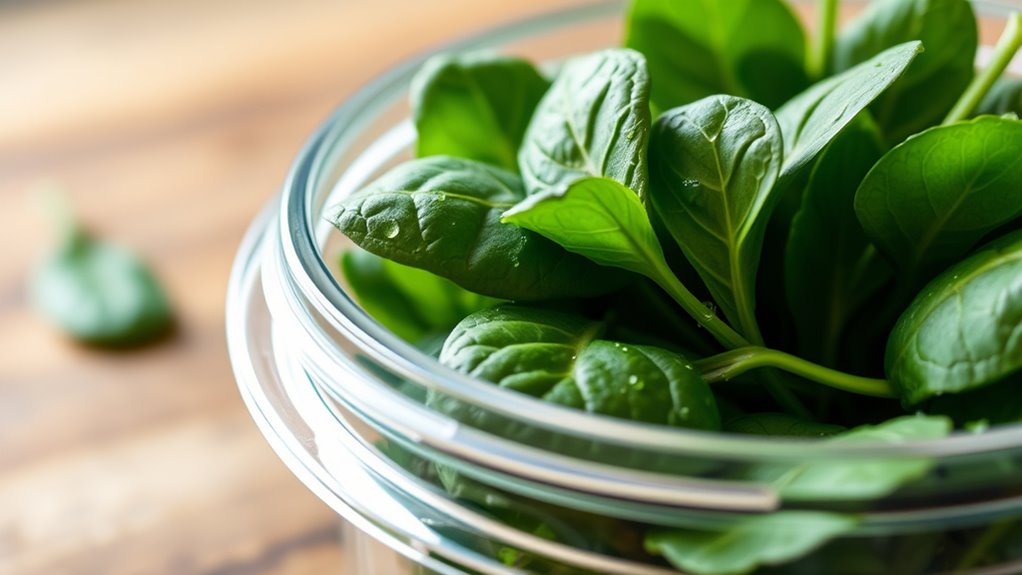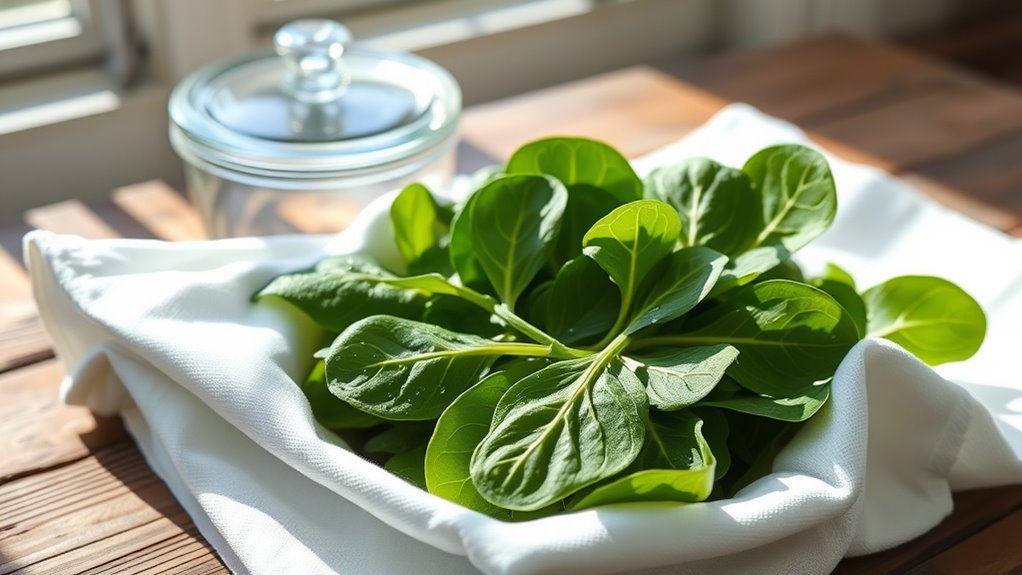To keep your spinach crisp and green, store it in the crisper drawer of your fridge. Use breathable bags or produce keepers to regulate moisture. Avoid washing it until you're ready to use it, as excess moisture speeds spoilage. Paper towels can absorb unwanted moisture, while airtight containers also work well. Check regularly for any signs of spoilage, and consider freezing spinach for longer shelf life. There's plenty more to explore about keeping your greens fresh!
Key Takeaways
- Store fresh spinach in the crisper drawer of the refrigerator to maintain optimal freshness.
- Use breathable bags or produce keepers to regulate moisture and prevent spoilage.
- Wrap spinach in paper towels to absorb excess moisture and keep leaves crisp.
- Check regularly for moisture accumulation to ensure good air circulation and prevent mold.
- For long-term storage, freeze spinach after washing and drying, using portion-sized bags.
Shelf Life of Fresh Spinach

Fresh spinach has a shelf life of about 5 to 7 days when stored properly in your refrigerator. Factors like temperature, humidity, and packaging play a crucial role in how long it stays fresh.
To maximize its lifespan, always store spinach in the crisper drawer, which maintains optimal conditions. If you buy spinach in unopened containers, it'll last the full week, but once opened, expect about 3 to 5 days.
Store spinach in the crisper drawer for maximum freshness, lasting up to a week in unopened containers.
Minimize exposure to air and moisture by using airtight containers or wrapping it in paper towels. Keep an eye out for spoilage indicators such as slimy textures, mold, or off odors, and remove any damaged leaves to keep the rest fresh longer.
Enjoy your spinach while it's at its best!
Importance of Moisture Control

Why is moisture control so critical for storing spinach? Excess moisture can spoil your spinach quickly, causing mold growth and sogginess.
To keep your leaves crisp and vibrant, you need to maintain low humidity levels in storage. Using a paper towel in your bag helps absorb any excess moisture, preventing spoilage.
Additionally, consider breathable bags or specialized containers designed to keep moisture away. Regularly check your spinach for signs of moisture accumulation, and ensure good air circulation around your stored greens.
Remember, the right moisture control doesn't just retain freshness; it also preserves the color, flavor, and nutrients of your spinach.
Best Storage Containers for Spinach

When it comes to storing spinach effectively, choosing the right container can make all the difference in maintaining its freshness and quality.
Consider using produce keepers, which regulate moisture and often come with vents and water trays. Breathable bags are another great option, allowing airflow to prevent moisture buildup.
If you prefer something durable, PET containers provide clear visibility and are recyclable. Airtight containers with paper towels help absorb excess moisture, keeping your spinach dry.
For frequent use, reusable containers with ventilation are cost-effective and environmentally friendly.
Assess your storage needs and opt for containers that offer ventilation, secure closures, and BPA-free materials to ensure safe and effective storage.
Advanced Storage Techniques

To maximize the freshness of your spinach, employing advanced storage techniques is essential.
Start by maintaining storage temperatures between 0°C and 5°C to extend shelf life. Control humidity levels, as a high-humidity environment prevents wilting but avoid excess moisture, which leads to decay.
Maintaining storage temperatures between 0°C and 5°C is crucial for extending the freshness of your spinach.
Consider using Modified Atmosphere Packaging (MAP) to manage oxygen and carbon dioxide levels, slowing spoilage. Keep ethylene-producing fruits like apples and bananas away from your spinach to prevent premature spoilage.
Use paper towels in containers to absorb excess moisture and prevent mold growth. Additionally, store unwashed spinach to minimize moisture accumulation and ensure airflow with breathable containers.
Monitoring these factors will help keep your spinach crisp and green for longer.
Freezing Spinach for Long-Term Use

Freezing spinach not only extends its shelf life but also preserves its nutrients, making it a smart choice for long-term use. You can freeze spinach without blanching for up to three months or up to six months if you blanch it first. Blanching helps maintain its vibrant color and texture.
Start by washing the spinach thoroughly, removing excess moisture, and chopping larger leaves if needed. For convenience, consider freezing in portion-sized bags to prevent unnecessary thawing. Remember to remove air from the bags to minimize freezer burn.
Label each bag with the date, and store them at 0°F (-18°C) for optimal preservation. This way, you'll have nutritious spinach ready to enhance your meals anytime!
Handling Pre-Cooked Spinach

Handling pre-cooked spinach requires attention to detail to ensure it stays fresh and safe to eat.
First, cool the spinach to room temperature before storage. Use airtight containers or storage bags to keep it fresh, and opt for glass containers to prevent stains and odors.
Store it in the refrigerator for up to 5 days, or freeze it in freezer-safe containers for up to 6 months. Make sure the containers are dry to control moisture and prevent spoilage.
Always label and date your containers to use the older spinach first.
When reheating, bring it to an internal temperature of at least 165°F (74°C) and check for any signs of spoilage before consuming.
Commercial Preservation Methods

Preserving spinach in a commercial setting requires advanced techniques that go beyond simple refrigeration. One effective method is vacuum packing, which removes air to extend shelf life.
Modified atmosphere packing uses specific gas compositions to maintain freshness, while freeze-drying eliminates moisture for long-term storage. You might also consider blanching and salting as pre-treatments for some preservation methods.
Storage conditions play a crucial role, so keep spinach at consistent temperatures between 32°F and 50°F, manage humidity, and ensure proper ventilation. Rapid precooling right after harvest can help maintain quality, and specialized storage containers, like LDPE bags, can enhance preservation.
Tips for Keeping Spinach Fresh Longer

While you may think that simply refrigerating spinach is enough, there are several effective strategies to keep it fresh longer.
Start by choosing fresh bunches instead of pre-washed varieties, as they last longer and often cost less. Inspect the leaves for any yellow or brown spots and remove damaged ones.
Wash your spinach in cold water but dry it thoroughly using a salad spinner or paper towels to prevent excess moisture. Store it unwashed in dry containers, including paper towels to absorb moisture.
Use sealed containers in the crisper drawer and keep them upside down to avoid pooling. Regularly check your spinach for spoilage and use the oldest leaves first to minimize waste.
Frequently Asked Questions
Can I Store Spinach With Other Vegetables?
You can store spinach with other vegetables, but it's essential to manage moisture and ethylene levels.
Keep spinach away from ethylene-producing fruits like apples and bananas, as they can speed up spoilage.
Consider pairing spinach with leafy greens or dry cruciferous vegetables.
Use breathable containers and check on them regularly.
If you maintain proper humidity and temperature, your spinach can stay fresh alongside other veggies for a longer period.
How Can I Tell if Spinach Is Spoiled?
Imagine reaching for a vibrant salad, only to find wilted, discolored spinach lurking in your fridge.
To tell if spinach is spoiled, inspect the leaves closely; they should be bright green and crisp. If you notice dark spots, sliminess, or a musty smell, toss it out.
Soft, wilting leaves signal it's time to say goodbye. Always trust your senses; fresh spinach should invigorate your meals, not bring unwanted surprises!
Is It Safe to Eat Wilted Spinach?
Yes, it's generally safe to eat wilted spinach as long as it hasn't started to rot or develop slime.
Check its appearance, smell, and texture—if it feels soft but still smells fresh, you can go ahead and use it.
Cooking wilted spinach can also enhance its flavor.
Just be cautious of any signs of spoilage, and remember that while it's safe, it mightn't have the same nutritional value as fresh spinach.
Can I Use Frozen Spinach in Smoothies?
Absolutely, you can incorporate frozen spinach into your smoothies!
It's a fantastic way to add a burst of nutrients without the hassle of fresh preparation. Its mild flavor complements fruits beautifully, while its vibrant green hue enhances visual appeal.
Plus, the freezing process locks in essential vitamins and minerals, ensuring you get all the health benefits.
How Can I Revive Wilted Spinach?
To revive wilted spinach, submerge it in ice-cold water for 15 to 30 minutes. This rehydrates the leaves, restoring their crispness.
You can enhance the effect by adding a tablespoon of salt per quart of water.
After soaking, dry the spinach using a salad spinner or towels.
For best flavor and texture, use the revived spinach immediately, or store it in breathable bags lined with paper towels to keep it fresh.
Conclusion
To keep your spinach crisp and green, remember that moisture control is key. Whether you're using a simple zip-top bag or a high-tech vacuum sealer, the right storage method makes all the difference. Just like a medieval knight wouldn't venture into battle without their armor, don't forget to protect your greens from spoilage. By following these tips, you'll enjoy fresh spinach for longer, adding vibrancy and nutrition to your meals without any hassle.










